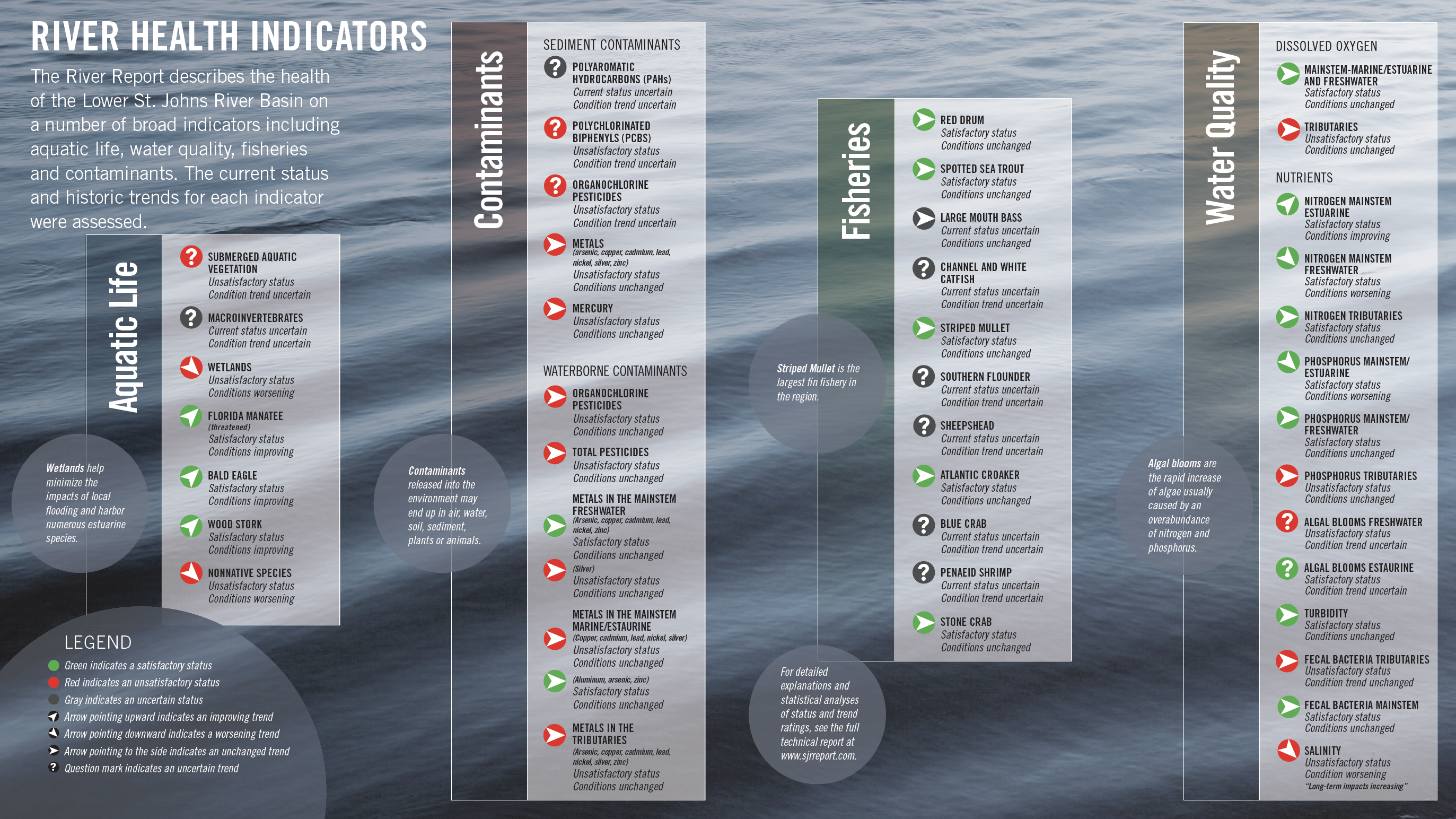Welcome to the Lower St. Johns River Basin “State of the River” Report.
The State of the River Report is a collaborative effort by a team of academic researchers from Jacksonville University, University of North Florida, Jacksonville, FL; and Penn State Berks, Reading, Pennsylvania. The report is supported by the Environmental Protection Board of the City of Jacksonville. The purpose of the project is to review data and literature about the river and to present it in a format readable to the general public. The report consists of four parts: the website, the brochure, the full report, and an appendix. The brochure provides a brief summary of the status and trends of each indicator (i.e., water quality, fisheries, etc.), and the full report and appendix contain the full background, analysis, and status and trend evaluation. Many different sources of data are examined, including data from the Florida Department of Environmental Protection, St. Johns River Water Management District, Fish and Wildlife Commission, City of Jacksonville, individual researchers, and others. The most statistically rigorous and stringent research available is used to assemble the report. An extensive peer review of the draft report is undertaken each year to ensure accuracy, balance, and clarity.
Executive Summary
The Sixteenth State of the River Report is a summary and analysis of the health of the Lower St. Johns River Basin (LSJRB) available at https://www.sjrreport.com. The Report addresses four main areas of river health: water quality; fisheries; aquatic life; and contaminants. This year’s findings indicate the need for concern in many aspects of the health of the River.
- Fecal indicator bacteria in the tributaries continue to cause significant concern; 60 Duval County tributaries exceed the applicable water quality criterion as seen in the most recent data run for the Impaired Waters Rule. Six tributaries have actually registered increases in their fecal indicator bacteria concentrations by over 10% in the last seven year period, despite efforts to reduce these levels.
- Salinity trends reveal a long-term increase from 2008 to 2022, attributable to both natural phenomena and human activities, and this increase has yielded a change in river ecology, particularly in a loss of submerged aquatic vegetation in the northern section of the basin.
- Harmful algal blooms appear sporadically in the basin, and the factors that contribute to them – nutrient inputs, habitat changes, and climate change – are not adequately addressed.
- The non-native aquatic species count is estimated at 100 species this year, an increase over the 92 species observed last year. These non-natives can cause harm to human health, the regional ecosystem, and local economies.
- Contamination of the water column by the pharmaceuticals acetaminophen, ibuprofen, and hydrocodone is described for the first time; these compounds do not have a maximum allowable limit but are either stable or rising.
Some developments offer both positive and negative aspects:
- Dissolved oxygen (DO) levels in the mainstem remain satisfactory. In the tributaries, mean DO is stable above the reference value, but minimum DO levels and their outcomes depend upon location, season, and time of day.
- Total nitrogen (TN) across all reaches of the basin is satisfactory in both mainstem and tributaries; however, TN levels in the freshwater reach of the mainstem may be slightly increasing over the last decade.
- Total phosphorus (TP) in the tributaries remains unsatisfactory. TP in the freshwater reach of the mainstem remains stable but in the marine reach TP may be experiencing a rise over the last ten years.
- Submerged aquatic vegetation (SAV) shows slight increases in some areas of the basin this year, but losses in SAV over the last twenty years are still a concern.
- There have been some increases in wetland acreage in state-managed lands and a reduction in sanitary sewer outflow volume; however, acreage continues to be impacted due to high levels of environmental resource permitting for land development, with wetland mitigation typically for purchasing of wetland bank credits rather than creation or restoration of wetlands.
This year’s report and website offers a new Highlight on the past, present, and future of the American alligator, an iconic part of the cultural identity of Florida. The spatial distribution of alligator populations is determined typically by water salinity; the animals choose to inhabit freshwater tributaries and avoid the saltiest ones. They also prefer naturally vegetated shorelines to human-constructed structures. Jacksonville’s alligators tend to be small in size and isolated in population, likely due to hunting and trapping.
The full Report provides an in-depth look at the LSJRB. The Guide for the General Public summarizes key findings, their implications for recreation, and ways to get involved in the Lower St. Johns River Basin and its health. A new chapter showcases the K-12 educational resources on the LSJRB in the report and describes how to access and use them. The website hosts maps and data that visualize vulnerabilities along the river as well as the potential for resiliency. The website also features video clips on algae blooms, manatees, and oral histories of people who live, work, and recreate on the river. Section 1 provides an overview of the Report and the basin and describes the basin’s landscape, human occupancy, and environmental management from the 1800s to the present. Section 2 describes water quality in terms of dissolved oxygen, nutrients, algal blooms, turbidity, fecal coliform, tributaries, and salinity. Section 3 addresses the river’s finfish and invertebrate fisheries. Section 4 examines the condition of aquatic life, encompassing plants, animals, and wetlands. Section 5 discusses conditions and importance of contaminants in the LSJRB such as mercury; metals, in both sediments and the water column; polycyclic aromatic hydrocarbons; polychlorinated biphenyls; pesticides; and pharmaceuticals.

